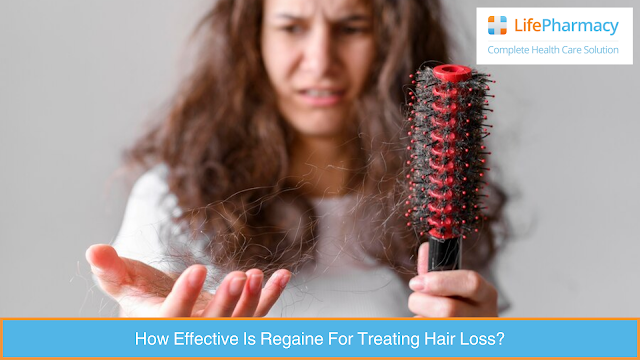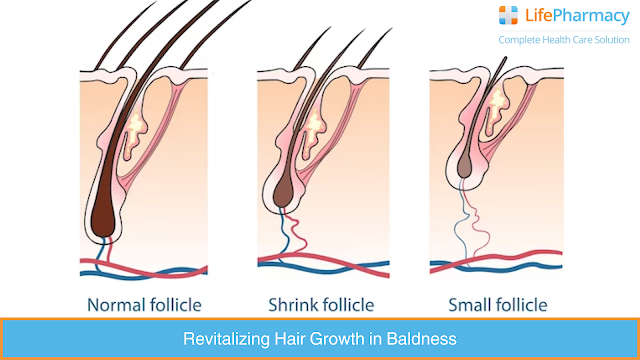Hair loss can be a distressing experience for many individuals, impacting self-esteem and confidence. People often explore various hair growth products and treatment options to regain lost hair. One such option that has gained popularity is Regaine.
In this blog, we'll delve into the effectiveness of Regaine for treating hair loss and explore how it works.
What is Regaine?
Regaine, also called minoxidil, is well-known for treating hair loss. It has become a popular choice among people dealing with thinning hair.
Originally in the 1960s, scientists developed Regaine as an oral medication to address high blood pressure. Regaine emerged as a promising vasodilator, meaning it expanded blood vessels to improve blood flow. While it did prove effective in lowering blood pressure, researchers and patients soon noticed an intriguing and unexpected side effect – the stimulation of hair growth, although sometimes in undesirable places.
Researchers thus developed a topical application to target specific areas requiring hair growth. This innovation allowed users to apply the medication directly to the scalp, minimizing side effects in the body and boosting hair growth.
Today, Regaine is a widely used over-the-counter treatment available through UK Chemists for androgenetic alopecia, commonly known as male and female pattern baldness.
Revitalizing Hair Growth in Baldness
Male Pattern Baldness occurs when tiny holes on the scalp, known as hair follicles, shrink. This shrinking leads to the production of thin and weak hairs, eventually causing hair loss. Aging is a common factor in this process, as hormonal changes contribute to follicle shrinkage. Genetics also play a role, with some men genetically predisposed to this condition.
Regaine with its active ingredient minoxidil, addresses this issue by widening the blood vessels in your scalp and opening potassium channels. This improves blood flow to hair follicles, providing them with the essential oxygen and nutrients for healthy hair production. Thus, increased circulation extends the growth phase of hair, promoting thicker and longer hair strands.
The hair growth cycle involves three stages: growth, transition, and resting. In Male Pattern Baldness, hairs spend less time in the growth stage, leading to quicker hair loss. Regaine works by shifting hair follicles from the resting phase to the growth stage and increasing the duration of the growth phase. While initial treatment may result in temporary extra hair shedding, it ultimately extends the growth phase, promoting fuller and healthier hair growth.
How Quickly Does Regaine Stop Hair Loss?
Regaine is a scientifically proven treatment for hair loss and scalp. People have observed that their hair becomes longer and thicker with its use. The topical application transforms into its active form, minoxidil sulfate, upon contact with scalp sulfotransferase. The variation in sulfotransferase activity among individuals may lead to some experiencing faster or better results.
Most users will not notice significant changes until around eight weeks into treatment, with the most noticeable improvements occurring after four months. Research indicates that applying Regaine halted hair loss for approximately 50% of men with male pattern baldness, with a smaller percentage experiencing hair regrowth.
Regaine is available as a 2% or 5% solution and a 5% foam. In a study comparing the effectiveness of 2% and 5% solutions in men with male pattern baldness, those using the 5% solution saw quicker results and 45% more hair regrowth after 48 weeks.
Regaine also works on a receding hairline but it is most effective on thinning hair, and recently lost hair. However, Regaine is ineffective for individuals who are bald since the hair follicles on the scalp have been inactive for an extended period. Permanent changes have occurred in the follicles during this time, making reversal unlikely.
While Regaine is a popular hair loss treatment for male pattern baldness, it has been proven effective for women experiencing hair loss. Hair loss in women, particularly after menopause, is more common than some may realize. Many females experience thinning or loss of hair at some stage of their livelihood.
After clinical trials and FDA approval, Regaine became a viable option for females with hair loss. It stimulates new hair growth, particularly fine hair, and experts recommend women use Regaine for six months to 1 year to assess its effectiveness. Women may use a lower concentration of minoxidil compared to men.
However, new hair growth is lost when individuals discontinue its application. Consistent and long-term use is recommended for optimal results. Thus, get your monthly stock of Regaine from UK Pharmacy.
Considerations and Side Effects of Regaine
Regaine is generally considered safe by experts, but the alcohol in the topical application may cause skin irritation. Potential side effects include increased sensitivity to sunlight, a dry and irritated scalp, headaches, burning, itching, and scaling. Users should be cautious about sun exposure to prevent sunburn. Using minoxidil may also cause hair color and texture to change.
Some users of the stronger 5% solution reported unwanted hair growth on areas like the forehead or cheeks. Allergic reactions to minoxidil or other ingredients are possible. Excessive use of minoxidil can lead to symptoms like light-headedness, nausea, and vomiting, indicating possible entry into the bloodstream, and necessitating a doctor's visit.
If symptoms like facial swelling, heart palpitations, dizziness, nausea, weight gain, or chest pain occur, discontinue its use and seek medical attention.
Pregnant or breastfeeding women shouldn't use Regaine because there is not enough information about how the medication might impact the fetus. While side effects are uncommon, Regaine is generally considered safe.
Regaine is safe for use on the beard and eyebrows, not just the scalp. Many have noticed a thicker and fuller beard with this treatment. However, it's important to note that Regaine is not licensed for use on the face, and scientific studies have primarily focused on its use on the scalp. While Regaine can irritate the scalp, the skin on the face is more sensitive, making dryness and irritation more likely.
Additionally, the increased blood circulation around the face may lead to a faster absorption of Regaine into the bloodstream, potentially raising the risk of side effects. For any side effects on your skin, you can avail of skin care products through Chemist Online UK.
How to Use Regaine?
Using Regaine is a straightforward process. Here's a general guide on how to use Regaine.
Regaine is available in different formulations, including liquid solution and foam. Choose the one that suits your preference and is easy for you to apply.
Ensure your scalp is both clean and dry before the application of Regaine. For optimal absorption, it is recommended to apply Regaine to a dry scalp. The presence of water on your hair can potentially dilute the solution, diminishing its effectiveness.
Part your hair to expose the area where you intend to apply Regaine, ensuring direct contact with the scalp. When applying the solution, especially for those with long hair, move it aside to facilitate direct application to the scalp. To ensure comprehensive coverage, consider dividing your scalp into six sections and applying the solution to each part.
For the liquid solution, use the dropper to apply the recommended amount directly to the affected areas on your scalp. For the foam, dispense the foam onto your fingers and gently massage it into the scalp.
After applying Regaine, wash your hands thoroughly to avoid unintentional contact with other areas, especially the face and eyes.
Follow the recommended dosage on the product packaging or according to healthcare professional direction. Avoid overuse.
Use Regaine twice every day to get the best results. Since it leaves your body quickly (in about 22 hours), it's essential to apply it regularly.
Male pattern baldness (MPB) is triggered when testosterone converts to DHT, leading to the shrinking of hair follicles. Thus, Regaine is often used together with finasteride, a dihydrotestosterone (DHT) blocker.
Many individuals incorporate a derma roller into their hair loss treatment routine, believing that the tiny needles on the roller can enhance circulation and stimulate collagen production, ultimately promoting hair growth. While some men report positive outcomes, it's important to note that scientific research supporting the effectiveness of derma rollers in treating hair loss is limited, and the theoretical science behind their use is not fully established.
Treat Hair Loss With Regaine From UK Pharmacy
Regaine, known for its transition from a blood pressure medication to a popular hair loss solution, is readily available over-the-counter with UK chemists. It has shown effectiveness in treating hair thinning and encouraging hair growth.
However, like all medications, Regaine comes with its own set of potential side effects. Therefore, it is crucial to consult with a healthcare professional before beginning any treatment for hair loss to ensure the best and safest results.


Comments
Post a Comment